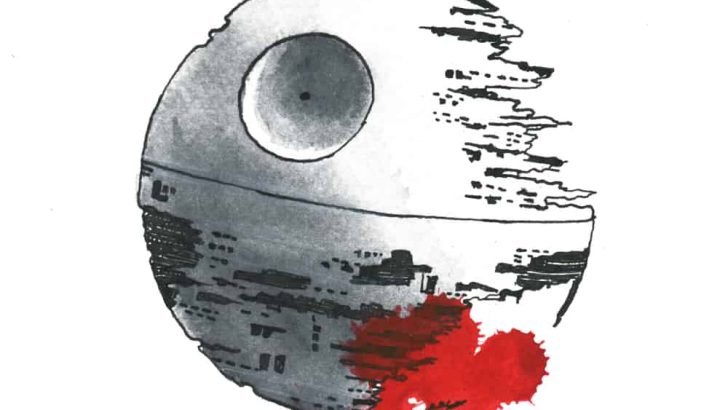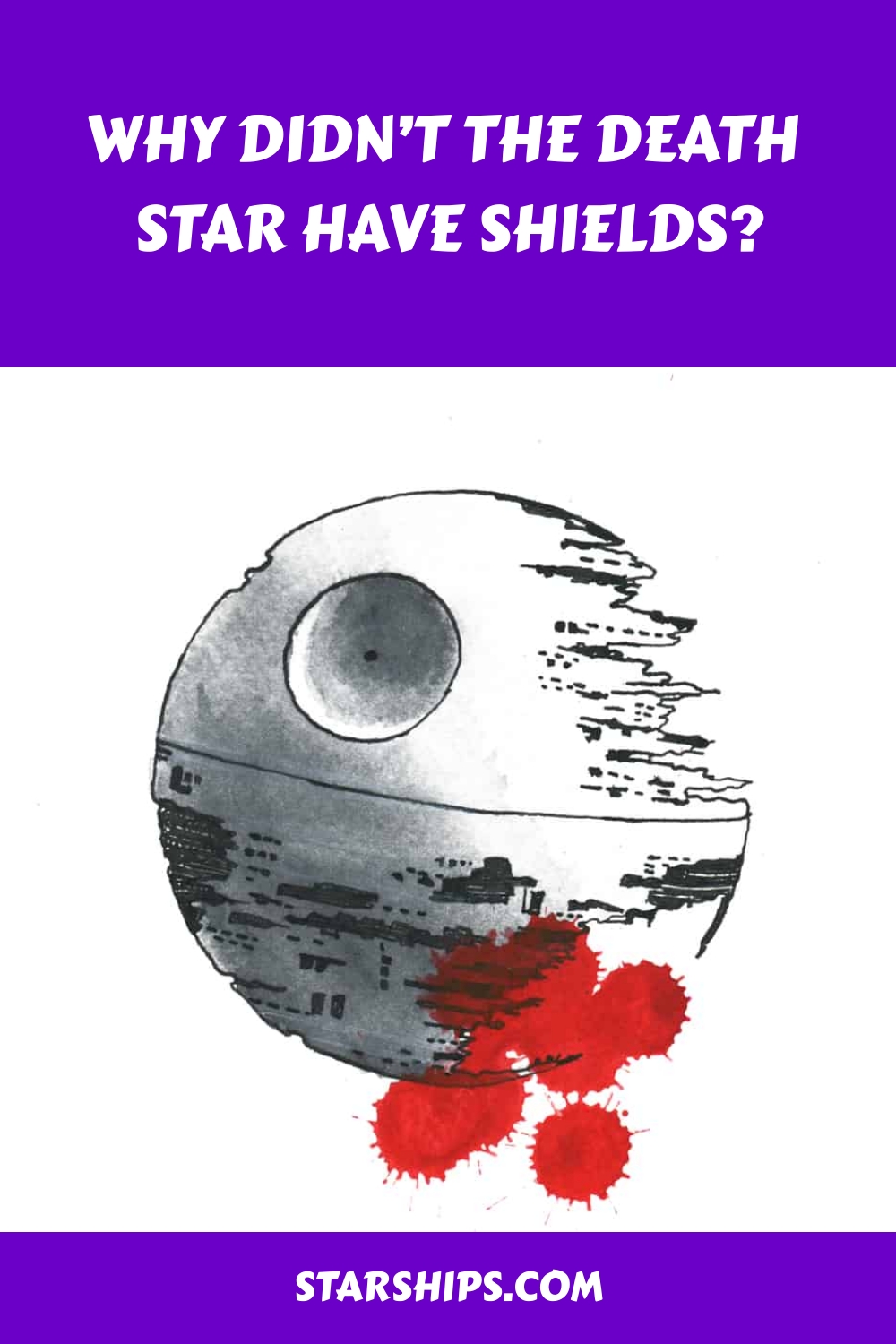Who doesn’t remember the iconic Star
Wars scene?
Why didn’t the Death Star have shields? The original Death Star did have shields. This was observed when Luke had to maneuver around the Death Star’s magnetic field. The only weak point in the Death Star was its exposed exhaust pipe. The Death Star 2 was the one that was destroyed by Lando, and it was the one that lacked shielding.
People who are fans of the immensely popular and iconic movie series most likely already know the answer to this question. For the off chance that you don’t know, we are going to take an in-depth look at the Death Star 1 and Death Star 2 to identify ultimately what lead to their destruction.
Design of The DS-1 Orbital Battle Station (Better Known As Death Star 1)
The DS-1 Orbital Battle Station, which has become known throughout the iconic Star Wars series as Death Star 1 was a moon-sized battle station that was designed to be impenetrable and had the capability to destroy entire planets with its cannon.
The Death Star 1 was built to be a symbol of the Emperor’s power and strike fear into anyone who might oppose the dark lord. Let’s be honest; no one in the right mind is really going to challenge a person who has an indestructible battle station that can blow up planets.
The DS-1 Orbital Battle Station was built with a spheroid design that had an unbelievable amount of levels within the battle station. 357 of them to be precise. Its overall size was impressive as well, with a 160 km (100-mile diameter).
One feature of the Death Star 1 that stood out was the concave dish that was placed on the northern hemisphere of the battle station to make up the planet-destroying super laser that the Death Star 1 was feared for.
Within the DS-1 Orbital Battle Station’s equator, there were multiple docks for the battle station to take on and release smaller ships for an extremely aggressive offense and defense combination and also supported an immensely powerful tractor beam generator.
The Armaments of the DS-1 Battle Station
The original Death Star was equipped with a hyper-destructive, planet-destroying super laser that was powered by a ridiculously powerful hyper matter reactor with its power being focused through giant kyber crystals. The hyper matter reactor was located at the center of the DS-1 Battle Station and provided energy for multiple components that the Death Star’s super laser was composed of.
The components that the hyper matter reactor powered were:
- The DS-1 Battle Station’s Primary Power Amplifier
- The Super Laser Power Cell
- The Firing Field Amplifier
- The Induction Hyperphase Generators
When the DS-1 Battle Station’s super laser was fired, the energy was directed through eight supporting beam shafts that were located along the perimeter of the super laser’s concave dish. The lasers that were produced would then converge, creating a single, powerful beam that was destructive enough to shatter a planet and bring an end to civilizations.
The drawback of this design and potentially a fatal flaw is that if the firing chamber relays were not aligned properly before firing a shot, the crystals would burn out and it could produce a massive amount of dangerous waste heat that could be sent back to the Death Star’s main reactor and potentially cause an explosion.
Defenses of the DS-1 Battle Station
The Death Star 1 had a reputation of
being indestructible, until well, it was destroyed of course.
Regardless of its destruction, it took the rebellion a lot of guts,
determination, and a
As you’ll see in this overview of the DS-1 Battle Station’s Defenses, you’ll understand why other than its destructive capabilities, why the Rebellion Alliance believed it couldn’t be destroyed.
In a defensive design that provided simultaneous offensive and defensive capabilities, the DS-1 Battle Station was covered with turbo laser batteries throughout the surface of the battle station, around 15,000, in fact (the Empire loved their lasers).
Aside from the lasers that covered the surface of the battle station, the Death Star 1 was also equipped with 768 tractor beams and TIE fighters. The purpose of this was to provide another aspect of attack and defense against a larger enemy force and not individual starfighters as the Empire did not see them as a threat. Clearly, that was an oversight, as seen with Luke Skywalker accomplishing the task.
The final measure of defense that was applied to the DS-1 Battle Station was an assortment of shield projectors and communication arrays that were scattered across the surface of the battle station’s already armored surface. This ensured a nearly impregnable defense for the Empire’s aptly named Death Star.
The Destruction of DS-1 Battle Station
As we have clearly identified, the DS-1 Battle Station was a formidable weapon in the hands of the Empire. With deterrent capabilities that would make the threat of a nuclear bomb being launched looking more like getting hit with a pillow, it was clear to see why the Empire used it as a show of strength and power and destroying it was no simple task.
The DS-1 Battle Station was destroyed in the Battle of Yavin. The DS-1 Battle Station was completed, and with that, the alliance had to prepare for a massive offensive attack at the hands of the Empire, which had plans to completely wipe out the Rebel Alliance following the death of Obi-Wan Kenobi. To prepare and find the Death Star’s weakness, the Rebel Alliance launched Operation Skyhook.
Operation Skyhook
Operation Skyhook was a mission that the Rebel Alliance undertook to get the layout and technical schematics of the DS-1 Battle Station in hopes of finding its weak points and any potential blind spots that could ultimately lead to its destruction and prevent the end of the rebellion.
The operation turned up successful, and the Rebel Alliance found the Achilles’ heel that it was looking for in order to bring down the DS-1 Battle Station and weaken the Empire’s position in space. While they happened to identify the super weapon’s one weakness, exploiting it would turn out to be an entirely different matter.
The original plan was to fire upon the Death Star’s crystals to misalign them and cause a massive heat waste transfer to the battle station’s core, however, because the Death Star was designed to prevent that type of assault and the Empire already planning on attacking after letting the Rebel Alliance escape from the battle station to track their movements, that plan was not going to work, and they were short on time.
Luke & R2-D2 to the Rescue
With the pressure on the Rebel Alliance, R2-D2 analyzed the schematics of the DS-1 Battle Station and discovered a secondary weakness. There was an exhaust port that was 2 meters wide that if it were hit with a proton torpedo, it would destroy the entire battle station.
This small spot on the DS-1 Battle Station was the weak spot the Rebel Alliance needed to exploit, and it wasn’t shielded like the rest of the Death Star. However, it was still situated in a narrow trench and was protected by laser batteries, as well. This meant that only the best pilot with the best accuracy could potentially pull it off. (Hey, it was a slim chance, but better than what they had before.)
The only pilot capable of performing
this feat was
After nearly killing Luke, then subsequently being flung into open space by own of his own pilots in the confusion created by Han Solo and Chewbacca’s attack to assist Luke Skywalker, Luke succeeded in firing 2 proton torpedos into the exhaust pipe after turning off the auto-targeting system in his starfighter (which the Empire discounted as a threat) and much to the dismay of the Yavin, thinking the action reckless.
Shortly afterwards the Death Star exploded, killing everyone on board and having the Rebel Alliance being acknowledged as a legitimate challenge to the Empire’s military power. While epic, this led to there being an escalation in the war and other planets being occupied by the Empire that were previously left alone.
Notable Mention of DS-2 Battle Station (Death Star 2)
Without going too much into detail on this event, the DS-2 Battle Station’s destruction was significant and an opportunity for the Rebel Alliance to deal a crippling blow to the Empire with Emperor Palpatine there overseeing its construction.
This Death Star was significantly easier to destroy than the first in that its construction was not complete. The Rebel Alliance discovered from its spies that all its defense systems were not up and running, and if you were wondering why the Death Star didn’t have shields, it is because of this. The second Death Star was not complete when it was destroyed.
The DS-2 Battle Station was destroyed in the Battle of Endor, which was also cool for other important things like the prophecy of the Chosen One to bring balance to the Force being fulfilled and the fall of the Empire. If you’re confused, go ahead and binge-watch the series.
And in The End…
We hope that this has adequately answered your question about why the Death Star didn’t any shields. Remember, it was the second that lacked shielding due to not being completely constructed upon destruction.
To learn more about the Death Star 2, Emperor Palpatine’s death, and the Battle of Endor visit this link about The Entire Battle of Endor and read from start to finish or watch Star Wars Episode VI: Return of The Jedi. Better yet, watch the whole series! Thanks for reading and LET THE FORCE BE WITH YOU.





Leave a comment
You must be logged in to post a comment.